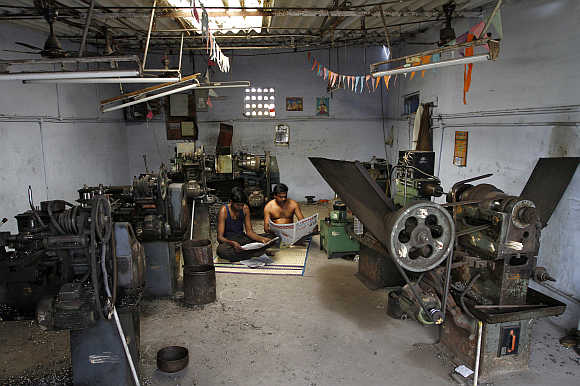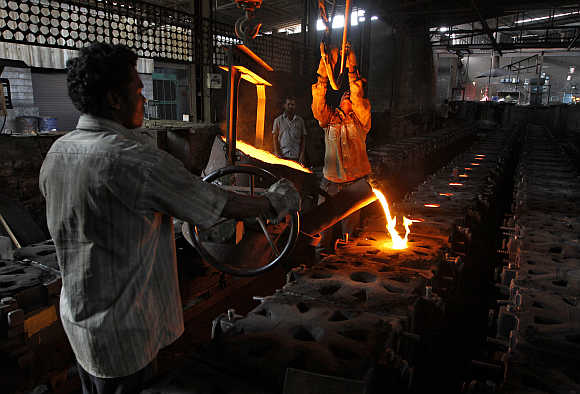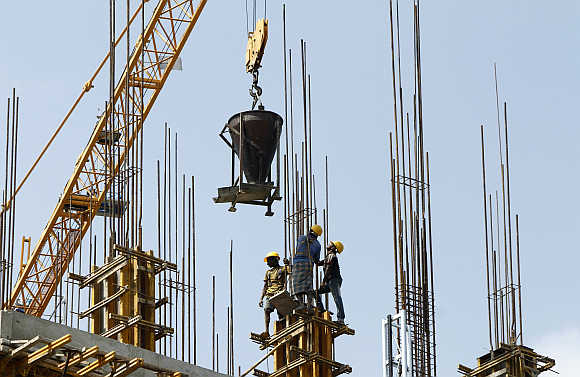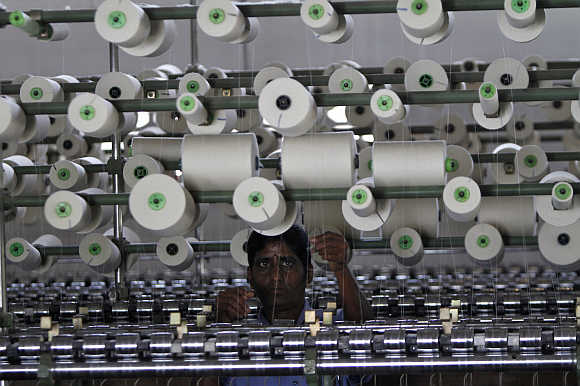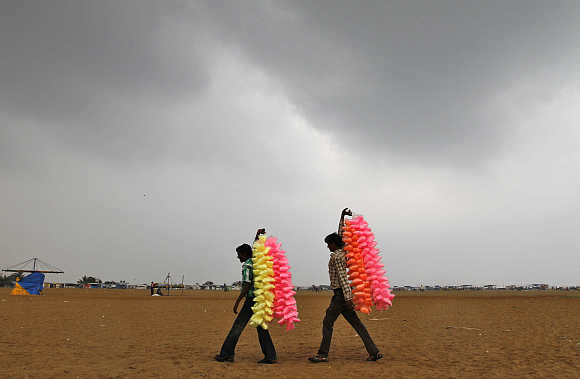 | « Back to article | Print this article |
Power shortage plunges business into crisis in south India
Coimbatore, the industrial town in Tamil Nadu, has over 50,000 small units. These make parts used in textile machinery, automobiles, household gadgets et cetera. Babu's unit, called SJ Industries, made parts for pumps.
In 2008, he had quit his job with a big unit, pawned his wife's jewellery, raised loans from friends and invested Rs 5.2 lakh in five machines. For the first year, business was good. Orders poured in. Then the electricity crisis hit him.
With eight to ten hours of power cuts, there was no way he could run the machines. Babu was unable to fulfill orders. Some months ago, he shuttered his unit, sold the machines and took up a job as a machine operator in another unit. Murugan, whose casting unit did business worth Rs 2 lakh a month till two years ago, now works as a labourer at a construction site.
Bashir from Ambur has shut his footwear component business and has taken up a job in a tannery. These aren't isolated examples. The acute power shortage in the four southern states - Andhra Pradesh, Karnataka, Tamil Nadu and Kerala - has caused thousands of businesses to suffer losses and shut down, resulting in massive job losses.
Click NEXT to read more...
Power shortage plunges business into crisis in south India
In Andhra Pradesh, where the power deficit is the highest, thousands of small and medium enterprises have closed, according to the Federation of Andhra Pradesh Chambers of Commerce and Industry. The state government says production loss due to the power shortage in 2012-13 was Rs 30,000 crore (Rs 300 billion). The federation puts the loss at Rs 70,000 crore (Rs 700 billion).
It also says that 6,000 units have become non-performing assets for banks - they have turned defaulters. The Federation of Andhra Pradesh Small Industries' Association says that units where almost Rs 57,000 crore (Rs 570 billion) has been invested are on the verge of becoming NPAs on the books of 48 banks.
The situation is hardly better in Tamil Nadu. In Coimbatore, thanks to power cuts of up to 10 and even 12 hours till two months ago, over 5,000 units have had to shut down, according to the Tamil Nadu Association of Cottage and Micro Enterprises, resulting in a loss of 50,000 jobs.
M Rafeeque Ahmed, the chairman of the Council for Leather Exports, says the leather clusters of Ambur, Ranipet and Vaniyambadi hardly get four to six hours of power in a day, which has forced almost a third of the around 600 small units there to shut down.
Annual exports of Rs 3,000 crore (Rs 30 billion) are down at least 15-20 per cent. Units that run on power generators have seen their profit margins fully eroded.
"Earlier, we used to compete with China and Bangladesh; not any longer," says Ahmed. The diary and calendar printers of Sivakasi say business is down 20-30 per cent.
Click NEXT to read more...
Power shortage plunges business into crisis in south India
Bigger companies, that can afford to generate their own power, too feel the pain. India Cements Vice-chairman & Managing Director N Srinivasan blames expensive captive power for the 60 per cent slump in the South-based cement producer's profit for the quarter ended March 2013 to Rs 40 crore (Rs 400 million).
His factories in Andhra Pradesh, Srinivasan discloses, face a "power holiday" of 12 days every month and up to four hours of power cuts every day. Hinduja Foundries, which happens to work in a power-intensive sector, has become sick because of the power woes.
"Power is the raw material for a foundry," Hinduja Foundries Chairman R Seshasayee says. "We cannot run a foundry on diesel generator sets."
There's more. Retail chains say people are buying fewer consumer electronics because of the precarious power situation.
H Vasanthkumar, the founder of Vasanth & Co, says air conditioner, washing machine and refrigerator sales are down 20 per cent. BA Srinivas, the chief executive of Vivek, says growth in television sales has fallen from around 50 per cent a year ago to 30-40 per cent.
A recent report in Deccan Chronicle says the long power cuts are driving women in Tamil Nadu, so far addicted to soap operas on television, to inexpensive pulp fiction! Sales of such novels, available for as little as Rs 10-15, have jumped 20 per cent. The chronic power shortages have robbed the South of some of its halo as a great investment destination.
Click NEXT to read more...
Power shortage plunges business into crisis in south India
When Hyundai set up its plant near Chennai in the 1990s, it was said that the state would soon become a global automobile hub. Proximity to the ports would make import of components and export of cars inexpensive. But the power crisis has become a huge deterrent. Chennai faces power cuts of two to four hours every day.
So, automobile companies like Tata Motors, Volkswagen and Maruti Suzuki have chosen to invest in the Pune belt of Maharashtra and Gujarat. Textile mills in Tamil Nadu have threatened to migrate to power-surplus Maharashtra and Gujarat.
Sensing the opportunity, senior Maharashtra government officers recently camped at Coimbatore to woo local businessmen. Of course, this option is available only to units who have the wherewithal to migrate lock, stock and barrel.
For smaller units, the choices are few. J James, the Coimbatore district president of the Tamil Nadu Association of Cottage and Micro Enterprises, says local units have been rendered uncompetitive by the power crisis.
"A part that costs Rs 25 in Coimbatore costs Rs 16 in Ahmedabad," he says. "Orders have started to move to Gujarat."
It is ironical that the power crisis has hit the southern states when the country has made record additions to its power capacity: Over 53,000 Mw in the last three years.
Arup Roy Choudhury, the chairman of NTPC, the country's largest power company, calls it a "paradigm shift in capacity addition".
Click NEXT to read more...
Power shortage plunges business into crisis in south India
The problem is that the south is not connected to the other regions. So, if there is surplus power in the other regions, only a small portion of it can be transmitted to the south.
As these four states are unable to tap into the national pool, electricity prices on the Indian Energy Exchange have dropped to around Rs 2 from Rs 4 a year ago. The good news is that the integration into the national grid may happen by February 2014.
RN Nayak, the chairman of Power Grid Corporation, says the transmission network can be laid only after new capacity gets added. Here's where the problem starts. Large projects that could have resulted in 17,060 Mw of power are stuck, largely because of high coal prices, problems related to land acquisition and delays in environmental clearances; the list includes Reliance Power's 4,000-Mw ultra-mega power plant at Krishnapatnam and IL&FS's 4,000-Mw unit in Tamil Nadu.
The 2,000-Mw nuclear power plant at Kudanmulam is delayed because of local protests. It was supposed to go on stream in 2007; it is expected to produce power only now. As much as 3,000 Mw of capacity is lying idle in Andhra Pradesh because of the fall in gas output from Reliance Industries' D6 block in the Krishna-Godavari basin. Lanco's Udupi Power is generating just 750 Mw out of its capacity of 1,200 Mw due to shortage of coal.
Click NEXT to read more...
Power shortage plunges business into crisis in south India
To compound the problem, water reservoirs have fallen to record levels, impacting the hydro-power plants in the region. Data from the Central Water Commission shows that in March, water in the Krishna basin, which is the largest in India and feeds the southern reservoirs, had fallen to 22 per cent of capacity - the lowest in the last ten years.
In Andhra Pradesh, Nagarjuna Sagar was down to 1 per cent of capacity in March from 20 per cent last year and Somasila went to 7 per cent from 61 per cent. The hydro-power plants are functioning at 15 per cent capacity in the state. In Karnataka, Krishnaraja Sagar fell to almost zero in March from 41 per cent last year, while the Kabini reservoir completely dried up.
The monsoon rains ought to have corrected the grim situation somewhat. Even when there is enough power, it is not certain how much power the four southern states will be able to buy: they together account for over 40 per cent of the loss of Rs 240,000 crore (Rs 2,400 billion) on the books of state power distribution companies.
To Nevyeli Lignite Corporation alone, Andhra Pradesh, Tamil Nadu, Karnataka and Kerala together owe Rs 3,457 crore (Rs 34.57 billion), says the company's chairman & managing director, B Surender Mohan.
Click NEXT to read more...
Power shortage plunges business into crisis in south India
In Andhra Pradesh, the power utilities don't have the money to refurbish 40- and 50-year-old plants in the state; these, as a result, are functioning at very low capacity. There's a large element of politics too. Andhra Pradesh, for instance, gives free power for seven hours every day to the agricultural sector in order to keep the politically strong farmer community happy.
As much as 40 per cent of the state's power is consumed by the farm sector. The Congress-led Karnataka government lays the blame at the doorstep of the earlier Bharatiya Janata Party government - it made no plans for the state's energy security and did not invest in laying transmission lines.
And in Tamil Nadu, Chief Minister J Jayalalithaa holds the Dravida Munnetra Kazhagam responsible. According to her, the DMK government added only 206 Mw of capacity during 1996 to 2001 and zero capacity during 2006 to 2011.
The capacity of 3,095 Mw that she initiated during her earlier term, 2001 to 2006, Jayalalithaa alleges, was not pursued by DMK. Now, Tamil Nadu is expected to add 6,000 Mw over the next two years, which should more than bridge the deficit of 2,683 Mw. It also wants to beef up its transmission and distribution infrastructure with an investment of Rs 9,000 crore (Rs 90 billion).
Till then, you could call it powerless existence.
